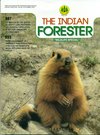Anthropogenic Mortality of Wildife: A Case Study Demonstrating Free Ranging Dogs Emerging as the only Predator in Thar Desert
DOI:
https://doi.org/10.36808/if/2018/v144i10/139574Keywords:
Thar Desert Wildlife Mortality Stray Dog RescueAbstract
Based on the catalogue data of Jodhpur wildlife rescue center it was observed that rescuing injured wild animals especially small antelopes is inefficient practice. Among the different factors responsible for injuring wild animals in the region, stray dog has been observed as a main factor responsible for their injury and mortality. Status survey of antelopes in whole Thar region using latest techniques, attempting possibilities of mobile rescue platforms, establishing rescue centers at field level to avoid trauma to wild animals, dealing with populations of dogs is needed and maximizing urban forestry programs to maintain escape habitats for wildlife are suggested.References
Banks P.B. and Bryant J.V. (2007). Four-legged friend or foe? Dog walking displaces native birds from natural areas. Biology Letters, 3: 611-613.
Bassi E., Canu A., Firmo I., Mattioli L., Scandura M. and Apollonio M. (2017).Trophic overlap between wolves and free-ranging wolf× dog hybrids in the Apennine Mountains, Italy. Glob. Ecol. Conserv., 9: 39-49. http://dx.doi.org/10.1016/j.gecco.2016.11.002.
Bergman D. and Bender S. (2009). Dogs gone wild : Feral dog damage in the United States. In: Proceedings of the 13th WDM conference, ed. J. Boulanger, 177–183. New York: Saratoga Springs.
Bhardwaj G.S. and Dutta S. (2015). Wildlife mortality in Jodhpur district: a case study of wildlife rescue in Jodhpur rescue center. Final report submitted to Rajasthan Government, India.
Doherty T.S., Dickman C.R., Glen S.A., Newsome T.M., Nimmo D.G., Ritchie E.G., Vanak A. T. and Wirsing A.J. (2017). The global impacts of domestic dogs on threatened vertebrates. Biological Conservation, 210(2017) 56-59
Dookia S. (2002). Habitat Preference, Abundance and Group Size of Indian Gazelle Gazella bennettii in Semi Arid Region of Thar Desert of Rajasthan. PhD. Thesis, J.N.V. University, Jodhpur, Rajasthan. 179. p.
Dookia S. (2016) Ecological Studies of Ungulates in Thar Desert of Rajasthan for Conservation Amplification-Final Report. Report submitted to SERB, Department of Science and Technology, under Young Scientist Scheme, Govt. of India, New Delhi. 45 p.
Dookia S. and Jakher G.R. (2013).Social organization and population dynamics of Indian Gazelle (Gazella bennettii) in Thar Desert of Rajasthan, India. Tiger Paper, 40(1):5-14.
Dookia S. and Jakher G.R. (2007). Food and feeding habit of Indian Gazelle (Gazellabennettii), in the Thar Desert of Rajasthan. Indian Forester, 133(10): 1327-1340.
Furtado M.M., Hayashi E.M.K., Allendorf S.D., Coelho C.J., Jácomo A.T.A., Megid J., Filho J.D.R., Silveira L., Tôrres N.M. and Neto J.S.F. (2016). Exposure of free-ranging wild carnivores and domestic dogs to canine distemper virus and parvovirus in the Cerrado of central Brazil. Eco Health 13: 549-557. http://dx.doi.org/10.1007/s10393-016-1146-4.
Hiby L., Dutta S., Chaudhari A., Kartal T., Bipin C.M. and Jhala Y.V. (2016) Roaming dogs in settlements to the west of Jaisalmer. Interim report to HIS and WII, India.
Hughes J. and Macdonald D.W. (2013).A review of the interactions between free-roaming domestic dogs and wildlife. Biological Conservation, 157: 341-351.
Mohandas M.S. (2017). Has Conservation Gone to the Dogs? Ecological Aspects of the Free ranging dogs in the Thar. Dissertation submitted to Saurashtra University, Rajkot in partial fulfillment of Master's Degree in Wildlife Science (June 2017). Wildlife Institute of India, Dehradun.
McAleece N., Gage J.D.G., Lambshead P.J.D. and Paterson G.L.J. (1997). Bio Diversity Professional statics analysis software. Jointly developed by the Scottish Association for Marine Science and the Natural History Museum, London
Ritchie E.G., Dickman C.R., Letnic M. and Vanak A.T. (2014). Dogs as predators and trophic regulators. In: Free-ranging dogs and wildlife conservation, Ed. M.E. Gompper, 55-68. Oxford: Oxford University Press.
Vanak A.T., Dickman C.R., Silva-Rodriguez E.A., Butler J.R.A. and Ritchie E.G. (2014). Top-dogs and under-dogs: competition between dogs and sympatric carnivores. In: Free-Ranging Dogs and Wildlife Conservation (Gompper, M.E. (Ed.),. Oxford University Press, Oxford, 69-93 pp.
Vanak A.T., Belsare A.V. and Gompper M.E. (2007). Survey of disease prevalence in free-ranging domestic dogs and possible spill-over risk for wildlife – a case study from the Great Indian Bustard sanctuary, Maharashtra - India. Final report submitted to the Rufford Small Grants Foundation, UK.
Vanak A.T. (2008 ). Intraguild interactions between native and domestic carnivores in central India. PhD dissertation, University of Missouri.
Zapata-RÃos G. and Branch L.C. (2016). Altered activity patterns and reduced abundance of native mammals in sites with feral dogs in the high Andes. Biological Conservation, 193:9-16. http://dx.doi.org/10.1016/j.biocon.2015.10.016.
Downloads
Downloads
Published
How to Cite
Issue
Section
License
Unless otherwise stated, copyright or similar rights in all materials presented on the site, including graphical images, are owned by Indian Forester.





